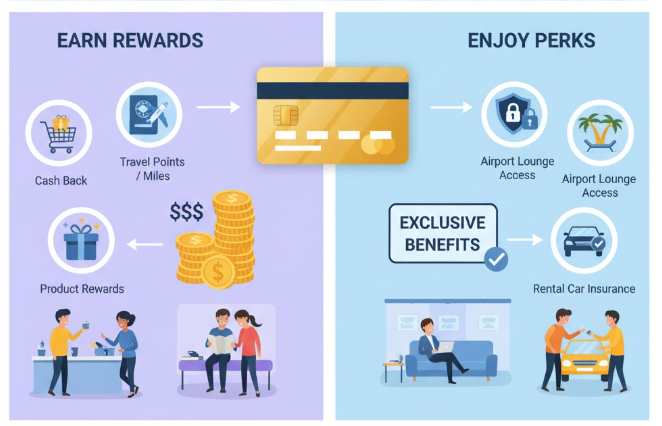Introduction: Turning Everyday Spending into Real Rewards
Imagine buying your morning coffee, filling up your gas tank, or paying your phone bill — and earning free travel, cash back, or exclusive privileges with every swipe. That’s the power of credit card rewards and perks.
Credit cards are no longer just tools for borrowing money — they’ve evolved into financial partners that can help you save, travel, and even access luxury experiences. But not all cards are created equal. Some offer generous points or miles, while others specialize in cash rewards or exclusive benefits.
This guide will walk you through everything you need to know — from how credit card rewards work to strategies that help you maximize them responsibly.
What Are Credit Card Rewards?
Credit card rewards are incentives offered by card issuers to encourage spending and loyalty. When you use your card for purchases, you earn rewards in the form of:
-
Cash Back – A percentage of your spending returned as money.
-
Points – Earned per dollar spent and redeemable for travel, merchandise, or gift cards.
-
Miles – Travel-focused rewards that can be used for flights, hotel stays, or upgrades.
These rewards can quickly add up — especially when you use your card strategically.
Types of Credit Card Reward Programs
Let’s explore the main types of rewards programs and how each can fit your lifestyle.
1. Cash Back Cards
Cash back cards return a fixed or variable percentage of your spending as cash.
Examples:
-
1.5% flat cash back on all purchases
-
3% cash back on groceries, 2% on gas, 1% on everything else
Best For: People who prefer simple, flexible rewards.
Pros:
-
Easy to understand
-
No complicated redemption process
-
Works for all spending categories
Cons:
-
May offer lower long-term value compared to travel rewards
2. Travel Rewards Cards
These cards earn points or miles for each dollar spent, which can be redeemed for flights, hotels, or travel upgrades.
Examples:
-
2x miles on all travel and dining purchases
-
Bonus miles when booking through the card’s travel portal
Best For: Frequent travelers and those who love exploring new destinations.
Pros:
-
High-value redemptions for flights or hotels
-
Access to airport lounges and travel insurance
-
Partner airline and hotel loyalty integrations
Cons:
-
Rewards are often tied to specific travel programs
-
Annual fees can be high
3. Store and Retail Rewards Cards
These are co-branded with a specific retailer, like Amazon, Walmart, or a clothing brand.
Example:
The Amazon Prime Rewards Visa offers 5% back on Amazon purchases and 2% at restaurants and gas stations.
Best For: Loyal customers who frequently shop with a particular brand.
Pros:
-
Special discounts or exclusive deals
-
Bonus rewards during sales or promotions
Cons:
-
Rewards often limited to one retailer
-
High interest rates if balances aren’t paid in full
4. Premium Rewards Cards
Premium cards are designed for big spenders and travelers who want VIP experiences.
Common Perks:
-
Airport lounge access
-
Concierge service
-
Travel credits or insurance
-
Elite hotel status
Examples:
Chase Sapphire Reserve, American Express Platinum.
Best For: Professionals and frequent flyers seeking luxury and convenience.
5. Business Rewards Cards
Tailored for entrepreneurs and business owners, these cards reward business-related expenses such as advertising, travel, and supplies.
Example:
Earn 3x points on office supply stores and online advertising.
Pros:
-
Simplified expense tracking
-
High reward rates on business categories
-
Employee card options
Cons:
-
Personal credit may still be used for approval
-
Annual fees can be higher
How Credit Card Rewards Work
To truly benefit, you must understand how points, miles, and cash back accumulate and convert.
| Reward Type | How You Earn | How You Redeem | Typical Value |
|---|---|---|---|
| Cash Back | Percentage of purchase amount | Direct deposit, statement credit | $1 = $1 |
| Points | Points per $1 spent | Travel, gift cards, shopping | $0.01–$0.02 per point |
| Miles | Miles per $1 spent | Flights, upgrades, hotels | $0.01–$0.03 per mile |
Example:
If you earn 2% cash back and spend $1,000 a month, that’s $240 in cash back each year.
Common Perks and Benefits That Add Real Value
Credit cards today go far beyond just rewards. Many come with perks that can save you hundreds (or even thousands) annually.
1. Travel Perks
-
Airport Lounge Access: Free entry to luxury lounges for comfort and refreshments.
-
Global Entry/TSA PreCheck Credits: Reimbursement for security fast-track programs.
-
No Foreign Transaction Fees: Save money when traveling internationally.
2. Protection Benefits
-
Purchase Protection: Covers items if they’re lost, stolen, or damaged.
-
Extended Warranty: Extends manufacturer warranty on eligible items.
-
Rental Car Insurance: Coverage when renting vehicles using your card.
3. Lifestyle and Luxury Perks
-
Concierge Services: Personal assistance for reservations, tickets, and events.
-
Exclusive Access: Early entry to concerts, VIP events, or dining experiences.
-
Hotel Upgrades: Complimentary breakfast, late checkout, or room upgrades.
4. Financial Tools
-
Credit Monitoring: Alerts about changes in your credit report.
-
Budget Insights: Track spending by category through your card’s mobile app.
-
Installment Payments: Convert large purchases into manageable monthly payments.
How to Choose the Right Rewards Card
Choosing the perfect credit card depends on your spending habits, goals, and lifestyle.
Step 1: Identify Your Spending Categories
Check your monthly expenses:
-
Groceries
-
Dining and entertainment
-
Travel and fuel
-
Online shopping
Pick a card that offers bonus rewards where you spend the most.
Step 2: Compare Reward Structures
Use this quick comparison:
| Card Type | Best For | Reward Example |
|---|---|---|
| Cash Back | Everyday use | 2% on all purchases |
| Travel Rewards | Frequent flyers | 3x miles on travel |
| Store Card | Brand loyalists | 5% on brand purchases |
| Premium Card | Luxury perks | Lounge access + credits |
| Business Card | Entrepreneurs | 3x on office supplies |
Step 3: Look Beyond Rewards
Consider:
-
Annual fees – Do your rewards outweigh them?
-
Interest rates (APR) – Pay balances in full to avoid charges.
-
Sign-up bonuses – Many cards offer large bonuses for meeting a spending target in the first few months.
Earning More: Smart Strategies to Maximize Your Rewards
Once you have the right card, use these techniques to get the most out of it.
1. Use Your Card for Everyday Expenses
Pay for groceries, fuel, utilities, and streaming subscriptions — but pay off your balance monthly.
2. Leverage Sign-Up Bonuses
Most cards offer introductory bonuses (e.g., earn 60,000 points after spending $4,000 in 3 months).
That’s like a free round-trip flight just for regular spending.
3. Stack Rewards with Online Portals
Use shopping portals or apps that offer extra points or cash back when you shop through them.
4. Combine Points Across Programs
Some banks let you transfer points between cards or to airline partners, increasing redemption value.
5. Time Your Big Purchases
Make large planned purchases during bonus periods to unlock extra rewards.
6. Set Up Auto Payments
Never miss payments — avoid interest charges that could erase your rewards.
Redeeming Rewards the Smart Way
It’s not just about earning — it’s about how you use your rewards.
1. Redeem for Maximum Value
-
Travel Rewards: Best value comes from booking flights or hotel stays.
-
Cash Back: Use it for statement credits or direct deposit — avoid low-value gift cards.
-
Points: Redeem for travel instead of merchandise when possible.
2. Avoid Poor Redemption Options
Some reward portals offer inflated prices for merchandise or gift cards. Always calculate value per point to ensure you’re getting a good deal.
3. Watch for Expiration Dates
Certain programs have points that expire after 12–24 months of inactivity. Keep your account active with small purchases.

Mistakes That Can Cost You Rewards
Even smart cardholders can make errors that reduce their benefits. Avoid these:
-
Carrying a balance – Interest charges easily wipe out your rewards.
-
Ignoring annual fees – Choose cards where perks outweigh costs.
-
Late payments – Can result in losing rewards or getting your account suspended.
-
Not reading the fine print – Reward categories can rotate or change.
-
Spending more just to earn rewards – Defeats the purpose if you’re overspending.
The Power of Credit Card Combinations
You can multiply rewards by using multiple cards strategically.
Example:
-
Card 1 (Travel) – 3x on flights and hotels
-
Card 2 (Groceries) – 4% back on supermarket spending
-
Card 3 (Everyday) – 2% on all purchases
This combo ensures you’re earning the highest rate in every category.
When Premium Cards Are Worth It
While some cards charge annual fees over $400, they can be worth every penny if you maximize the perks.
Example Breakdown:
| Perk | Estimated Value |
|---|---|
| Lounge Access | $400/year |
| Travel Credits | $300/year |
| Hotel Upgrades | $150/year |
| TSA/Global Entry | $100 (once every 4 years) |
| Total Annual Value | ≈ $950 |
Even with a $550 fee, the benefits far outweigh the cost if you travel frequently.
How Rewards Impact Your Credit Score
Using a rewards card responsibly can boost your credit score.
Positive Effects:
-
Regular on-time payments build credit history.
-
Low credit utilization (below 30%) shows responsible use.
-
Long account age improves credit profile.
Negative Effects:
-
Applying for too many cards at once triggers hard inquiries.
-
Carrying balances increases debt-to-credit ratio.
Tip: Treat your card like a debit card — spend only what you can pay off monthly.
Top Tips for Responsible Rewards Management
-
Pay in full every month — never pay interest.
-
Track reward categories using apps or spreadsheets.
-
Reevaluate annually — your lifestyle or card benefits may change.
-
Avoid impulse spending — rewards are worthless if you overspend.
-
Keep an emergency fund — don’t rely on credit cards for emergencies.
Quick Comparison Table: Reward Values by Type
| Card Category | Average Annual Fee | Reward Rate | Best Use Case |
|---|---|---|---|
| Cash Back | $0–$95 | 1.5–5% | Everyday purchases |
| Travel Rewards | $95–$550 | 2–5x points | Frequent travel |
| Store Cards | $0–$95 | 2–5% | Brand loyalists |
| Business Cards | $0–$150 | 2–4x | Business expenses |
| Premium Cards | $450–$695 | 3–10x | Luxury and global travelers |
Bonus: Reward Tracking Tools and Apps
Keeping track of multiple reward programs can be confusing.
Here are some popular tools that simplify the process:
-
AwardWallet – Tracks points, miles, and expiration dates.
-
MaxRewards – Shows which card gives you the most rewards per purchase.
-
TravelFreely – Helps plan and optimize travel credit card strategies.
Infographic: The Reward Lifecycle
Spend → Earn → Redeem → Repeat
-
Use card for everyday purchases
-
Earn points or cash back automatically
-
Redeem for cash, travel, or perks
-
Repeat — building value over time
(Imagine a circular flow infographic showing spending leading to rewards and redemption.)
Conclusion: Make Every Swipe Count
Credit card rewards can turn ordinary spending into extraordinary opportunities — from free vacations to hundreds in yearly cash back. But like any tool, the key lies in responsible and strategic use.
Start with one good rewards card that fits your lifestyle. Use it for regular spending, pay off your balance monthly, and watch your benefits grow.
When used wisely, your credit card isn’t just plastic — it’s a gateway to smarter financial living, richer experiences, and tangible rewards for the money you already spend.
So go ahead — make every swipe count.

